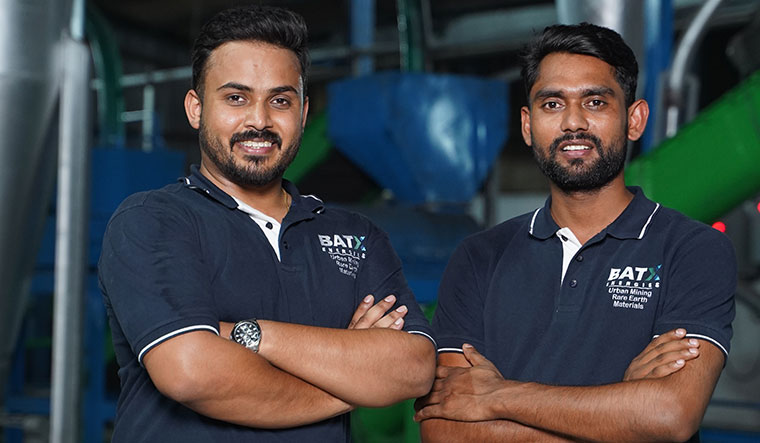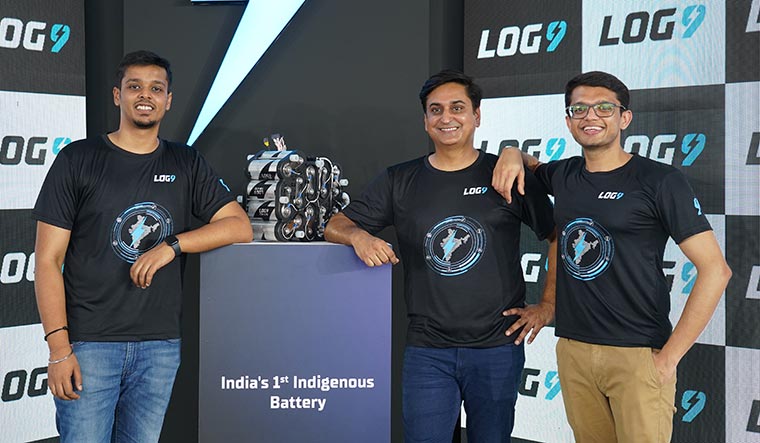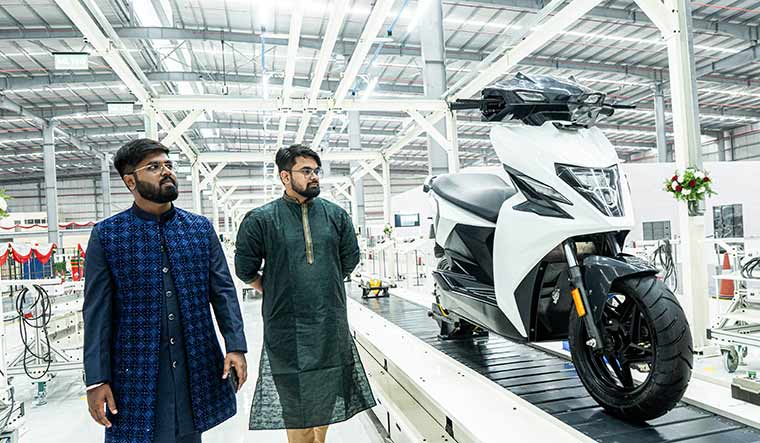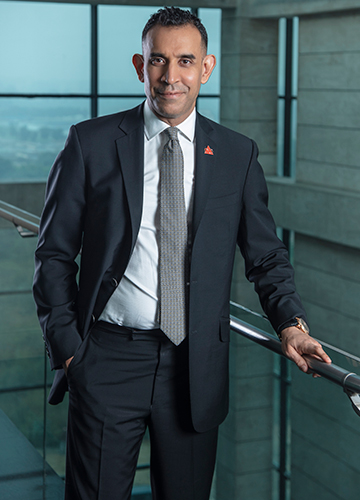Deep tech and new age energy are not epithets that flash in your mind while entering the Log9 headquarters near the Jakkur Aerodrome in northern Bengaluru. The whitewashed building is airy and filled with potted greens, with retrievers waddling around in the designated kennel area in the garden outside. An al fresco buffet dishes out hot meals on the rooftop, while geeks in tee-and-jean ‘uniforms’―the average age seems to be firmly on the right side of 30―roam about between foosball tables and smart meeting rooms.
But make no mistake, this understated campus is virtually the epicentre of India’s desperate thrust in a new global gold rush―a scramble for sustainable energy using clean sources and technology. Earlier this summer, Log9 turned heads and made headlines by making India’s first lithium-ion cells. Former ISRO chief K. Sivan gushed: “I want to see Log9 become another ISRO.” Log9 is barely eight years old, but already valued at Rs2,000 crore.
The reason for this palpable excitement is all in the requirements of the new energy mix. Just like black gold, aka oil, clean energy sources like solar and wind depend on ‘white gold’ or ‘green gold’―minerals and metals like copper, cobalt, zinc, silver and, especially, lithium. These are the raw materials that go into making batteries that power electric vehicles and other clean technologies.
The issue? Some of them, like lithium, are only available in a few parts of the world, where a veritable geopolitical gold rush has begun for control of these assets. Just like nations going to war for oil in the past, there is now a cold war over these resources.
India is in an unenviable position. The feasibility of the lithium deposits in Kashmir and Rajasthan is yet to be ascertained. Meanwhile, China, with its edge in new energy technologies and influence over mining contracts in Africa and South America, where minerals like lithium are found, is dangerously ahead in the race.
Obviously, India is not going to let China have a walkover. The government has started production-linked incentives for advanced cell chemistry, while most of the biggies of India Inc―Tata, Ambani, Mahindra, Adani―are jumping on the bandwagon, having revealed their intent to invest heavily in new age energy.
Yet, it is mostly in inconspicuous startup campuses like Log9’s that the revolution has begun, ignited in the minds of ambitious STEM graduates and entrepreneurial hopefuls. THE WEEK travelled across the country to meet some of these innovators who want to rewrite the rules of the game and are daring to dream the impossible, while putting India first.
THE CIRCULAR SHOT
Lohum and BatX give jugaad a good name with intrepid innovation
 BatX co-founders Utkarsh Singh (left) and Vikrant Singh.
BatX co-founders Utkarsh Singh (left) and Vikrant Singh.
IN THE GRIMY outbacks of western Uttar Pradesh, in an otherwise unremarkable industrial belt, are a clutch of factories that deal with scrap. Not your everyday waste, though―startups Lohum and BatX take used battery packs from electric cars and two-wheelers (primarily), and rip out hard-to-get minerals and metals like lithium for reuse.
Essentially, these companies use their patented technology to give a deep tech spin to the great Indian jugaad―if you do not have it, just reclaim and adapt. Lohum, in fact, is one of the biggest, billing itself as the world’s largest producer of sustainable battery raw materials through recycling.
“How do you talk about clean energy and yet go into mining, one of the most unclean activities, to get clean energy? A reasonable compromise is recycling,” pointed out Lohum founder and CEO Rajat Verma.
“Just like the availability of oil, there are barriers in availability and technology for countries like India, which do not have natural resources like lithium and cobalt,” said Utkarsh Singh and Vikrant Singh, co-founders of BatX. “To make India atmanirbhar, the only way is recycling. That is what triggered us to start this business.”
BatX developed its own hydro-metallurgy process to extract the materials. Lohum, too, has its own cleaning and extraction process, developed and patented by its 500-strong research and development team. “Recycling is an economically and environmentally superior activity,” said Verma of Lohum. “Throw in the geopolitical component and ESG (environmental, social and governance framework), then it checks all the boxes. Our idea is that we will use recycling to pave the way for energy transition.”
Battery packs are first dismantled to figure out how many good cells are left. The good ones go to a repurposing facility while the bad ones go for recycling. Each material of value is extracted and goes through its own unique process.
China is estimated to have around 40,000 recyclers, while Lohum and BatX are possibly the only two in India. That could change soon, once the windfall of batteries from the initial crop of bikes and cars turn up for recycling.
Meanwhile, these companies are not ready to rest on their laurels. Verma is looking at refining of materials like lithium, an area where China has a virtual monopoly, and becoming the largest chemicals and metals green energy company in India. “India has the fifth largest chemical industry in the world, with a cost factor similar to China and a large pool of chemical and energy talent,” he said. “We just have to go out and look for investors who are willing to take it to the next level.”
THE PATHBREAKERS
There is a reason why India’s clean energy sector is waiting to see what Log9 does next
 Going places: (From left) Kartik Hajela, Pankaj Sharma and Akshay Singhal, co-founders of Log9.
Going places: (From left) Kartik Hajela, Pankaj Sharma and Akshay Singhal, co-founders of Log9.
FOR ALL ITS lofty aims of becoming nanotechnology and sustainable energy pioneers in the country, the first time Log9 hit national headlines was because of something entirely different. During Covid-19, founders Akshay Singhal, Pankaj Sharma and Kartik Hajela came up with a “Corona Oven”―a microwave-like contraption that could nuke the pesky coronavirus on anything, from your wallet to car keys.
Fast forward to 2023, the boys and their installations in Bengaluru and Hyderabad are the cynosure of all eyes in the green energy ecosystem in the country―after coming out with India’s first electric vehicle cells and first commercial li-ion manufacturing facility, the aim, and expectation, are sky high. “We will develop indigenous li-ion cells with the intent to revolutionise the mobility and energy sector, and collaborate with leading and evolving OEMs (original equipment manufacturers) across all segments to deploy our batteries and contribute to electric vehicle adoption in India,” said Sharma, co-founder and director.
While Log9 is into finessing and improving lithium battery technologies in formats like LTO (lithium with titanium oxide) and LFP (lithium with iron phosphate) to make them more energy dense and suitable for Indian conditions (read scorching Indian summers), they are also looking at future technologies, like the much-talked about sodium-ion batteries and aluminium fuel cells (AFC).
“AFC is an energy generation system that uses aluminium as fuel and with its high energy density, can provide long driving range to vehicles,” said Sharma. “It is more commercially viable and practical for the long-haul transportation sector in India as India is one of the biggest producers of aluminium.” He feels that the future could be a combination of li-ion alongside AFC as an on-board refueller. “It can be the next-gen ultimate solution for the electric mobility sector,” he said.
While Log9 has initiated early pilots, co-founder Singhal warned against getting overexcited, as technologies take time. “It is not like creating a protein bar,” he quipped.
THE PIVOT
Top dog in conventional batteries, Amara Raja is daring to make the biggest transformation in its history
WHEN TRENDS AND technology change dramatically, they are often not too kind to incumbents. Ask anyone from silent era movie stars to companies like Eastman Kodak and Blockbuster. In a world where electric mobility and clean tech are the buzzwords, where does that leave Amara Raja, one of India’s biggest lead-acid battery players?
For the Rs8,000 crore, Tirupati-based conglomerate that retails under the familiar Amaron brand, a smart pivot was in order. “About three years ago, we took the revolutionary step to transform ourselves from being just a battery manufacturer to being in the business of energy and mobility solutions,” Amara Raja Batteries Chief Technology Officer M. Jagadish told THE WEEK. “Under this transformation, we set up the new energy vertical and recently broke ground for setting up the Amara Raja Giga Corridor for lithium-ion cell and battery pack manufacturing.”
The eventual Rs9,500 crore plant in Mahabubnagar, Telangana, will be the biggest yet in the country, with the company’s memorandum of understanding with the state government also including an energy research and innovation centre in Hyderabad. “We are keenly engaged in creating an India-centric ecosystem for the design, development and manufacturing of advanced cell technologies,” said Jagadish. “All of this will cater to the fast-emerging electric vehicle sector, renewable energy markets and energy storage systems.”
Shrewdly enough, Amara Raja is not putting all its eggs in the new energy basket. Even while it is pumping money into clean energy, it is also doing major research aimed at improving lead-acid batteries, like looking at using newer materials to improve performance, decrease weight and increase durability. “L-acid battery technology has been around for more than 100 years and we believe it will continue to exist for many more years to come due to its high-level of maturity, cost effectiveness and its strong circular economy compliance,” said Jagadish.
MISSION IMPOSSIBLE?
This Simple yet sweepingly grand vision could just be possible
 Suhas Rajkumar (left), founder of Simple at a Simple One factory.
Suhas Rajkumar (left), founder of Simple at a Simple One factory.
SUHAS RAJKUMAR’S Simple One, a sleek electric scooter with a range of over 200km went on sale last month, though hindered by the withdrawal of government subsidies and vendor networks (the e-scooter was initially available only in Bengaluru). But, what sets his Yelahanka startup, Simple, apart is the complex route he took. On the road from roadmap to on-the-road, Simple One created everything in-house―power train, software, hardware and mechanical components.
“We want to become the Apple of EVs,” said Rajkumar. “That is a big term to use, but that is our agenda. We want to develop an R&D culture in India and manufacture in India. Today, what most companies in India do is assembling, not manufacturing. What we are doing is design, manufacture and assemble in India, so that we have cost control, product control and eventually a customer experience that is beyond what they have experienced in the last 25 years of two-wheelers in India.”
His vision for the road ahead is even more obsessive, if not frightening. Though still only in planning stages, Rajkumar is looking at bringing out India’s first locally built, hydrogen-fuelled car.
“There are hyper-performance hydrogen cars on track and recently Union Transport Minister Nitin Gadkari went to Parliament in a hydrogen car,” said Rajkumar. His vision? An Indian hydrogen car by 2027 or so, either built from the ground up, or in collaboration with global majors like Toyota (he has reached out), which is investing heavily in hydrogen technology for cars.
“We have room to think beyond lithium, to think of hydrogen-based technologies,” he said. “We will crack hydrogen soon―whether as hybrid or pure hydrogen format. Hydrogen will definitely be part of the automobile industry going forward.”
Rajkumar is clear on why he is dreaming the impossible. “If we are not adding value, then we should not be doing this,” he said. “The very existence of Simple is for innovation and to pave the way for technology.”
THE DREAM AND THE DRIVE
Uday Narang wants to transform the Indian heartland through green technology
IT IS A TALE of two villages. Or rather, bridging the gap between two types of villages―one, the idyllic village in Switzerland that Omega Seiki Mobility (OSM) founder Uday Narang calls home and the other, those in the heartland of his home nation.
“It is beautiful to hear ‘Tesla is coming’, etc, but we cannot leave the majority of this country behind,” said Narang. “Rural is where this battle for clean energy will be won or lost. And I want to help my country. I could have been chilling in my village in Switzerland. It is heaven! But, this is a country that needs this solution. Sometimes in life you find a cause, and this is my cause.”
In 2022, OSM launched electric cargo rickshaws for the semi-urban and rural markets. Recently, it came out with the OSM Stream City, an electric urban passenger vehicle that could prove a cleaner option to the ubiquitous autorickshaws. OSM’s line-up is already on the roads, even as conventional biggies like Bajaj, Piaggio and M&M are said to be working on medium-speed cargo or passenger vehicles.
An international commodity trader and hedge fund manager, Narang said he understands the importance of having control of commodities, and how “absolutely superbly” China has played the game. “I am not a fan of China, but they beat everyone at their own game,” he said. “India has the youngest and most aggressive population in the world. We have got to learn the lesson.”
Narang is already walking the talk, and thinking beyond just scooters and e-rickshaws. His target? The first three-wheeler running on hydrogen, still an evolving technology in much of the world.
“We have been working on it for two years,” said Narang. While R&D was one part, two other allied areas have been taking up time―one, continuous testing to ensure there is no room for error, and the other, setting up the supply chain network, right from components down to the charging infrastructure.
OSM is aiming for the unveiling by December, but as Narang himself said, testing and safety are paramount. “We cannot just put products on the road (like some are doing by just raising funds and bringing in inferior technology),” he said. “This is a marathon, not a sprint.”
OSM’s dreams go beyond the current products. It is looking at setting up a $200 million EV plant in Tamil Nadu, to add to its existing plants in Faridabad, Haryana and Chakan, near Pune. The company has interest in making drones, too. “I want to say I did something to help my country,” he said. “That is what is driving me. Sometimes, the biggest risk of all is taking no risk at all.”



